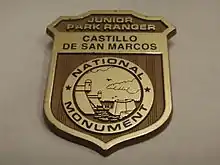Junior Ranger Program
The "Junior Ranger Programs" are activities prepared especially for 5- to 12-year-old visitors to the properties of the National Park Service. Children and their families participate in the program by completing prepared activity books which are generally free, but in a few cases can cost up to $3. The activity books direct children to areas they might otherwise miss, or to things of special interest to the age group. The booklets contain information that helps children and their families discover the importance of a park on their own terms, and decide what the park means to them personally. After completing the specified amount of pages for the child's age group, the participant is awarded a patch, badge and/or certificate, unique to each park. The Yellowstone National Park was the first to start the Junior Ranger program.

Specialty Badges and Patches

Some parks or groups of parks offer specialty badges or patches and a certificate signed by a ranger. For example, select participating parks now offer a Junior Civil War Historian badge for participants who complete three activities -- either junior ranger books at three parks or junior ranger books at two parks and one online activity. Select participating parks offer a Junior Paleontologist program. Select participating parks offer a Santa Fe National Historic Trail Junior Ranger program. Some sites also offer additional patches for older participants. Organ Pipe Cactus National Monument offers both a Junior Ranger patch and a Desert Ranger patch for older participants. Guadalupe Mountains National Park offers a Junior Ranger patch, a Senior Ranger patch and a Wilderness Explorer patch. Bandelier offers four different patches based on age groups. The parks either offer different books for different age groups or a single book that requires a different number of activities be completed based on the child's age. Often the activities are coded with a visual clue on which activities are appropriate for a particular age group. Parks may post their books on line so they can be printed out ahead of time, such as this one from Harper's Ferry National Historic Park.
- Junior Civil War Historian Program
- Junior Paleontologist Program
- Santa Fe National Historic Trail Junior Ranger Program
- Organ Pipe Cactus Junior Ranger and Desert Ranger
- Guadalupe Mountains Junior Ranger, Senior Ranger, Junior Paleontologist, Wilderness Explorer
- Junior Ranger Night Explorers
Some parks offer completion of their Junior Ranger programs by mail. You can download and print the book at home and mail it in once it's been completed. These are primarily offered at sites that are more remote and offer children the opportunity to learn about that location even though they can't actually visit in person.
- National Park of American Samoa
- Discovering the Underground Railroad
- War in the Pacific National Historical Park
Some badges are event specific and can only be earned during certain periods and only by those actually attending the event.
Other badges can be earned totally on line when a particular site is closed for an extended period of time.
There is also a new (as of 2019) Junior Ranger Passport Stamp program. The program is voluntary for the parks, but the stamps were sent out to parks with Junior Ranger programs. There may also be some parks with Junior Ranger cancellations that are not on the published list.[1]
Participating parks
Nearly all United States National Parks participate in the Junior Ranger Program, as well as National Monuments, National Historic Sites, National Recreation Areas, etc. Also many state parks also have a program as do some Bureau of Land Management areas but they may differ from the National Park Service program.
Reference
- "Junior Ranger Cancellation Station Locations" (PDF). June 1, 2019. Retrieved June 18, 2019.
External links
| Wikimedia Commons has media related to Junior Ranger (NPS). |
- Official website of the Junior Ranger Program
- Official website of the Web Ranger Program
- Junior Ranger Cancellation Station Locations
- Be a Junior Civil War Historian
- Oregon Junior Ranger Participating Parks List
- California Junior Ranger Participating Parks List - Note: California uses the same badge at all parks